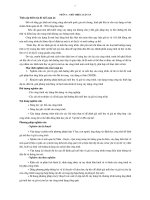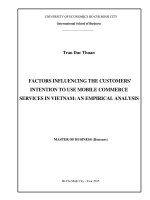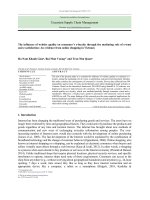công trình customers behavior on intention to purchase on online shopping in vietnam
Bạn đang xem bản rút gọn của tài liệu. Xem và tải ngay bản đầy đủ của tài liệu tại đây (502.55 KB, 16 trang )
<span class="text_page_counter">Trang 1</span><div class="page_container" data-page="1">
<b>BỘ GIÁO DỤC VÀ ĐÀO TẠO</b>
<b>ĐẠI HỌC KINH TẾ TP. HỒ CHÍ MINH</b>
</div><span class="text_page_counter">Trang 2</span><div class="page_container" data-page="2">Nguyễn Hồng Quế Trân (Leader)Bùi Ngọc Q
Đồng Mỹ LinhNguyễn Minh Nhật
</div><span class="text_page_counter">Trang 3</span><div class="page_container" data-page="3">Online shopping is rapidly expanding around the world and gradually replacing and-mortar stores. Almost three decades have passed since the first introduction in 1994, and over 2,64 billion people worldwide now use this service (Yaguara, 2023). With multiple effective transactions, e-commerce platforms provide customers with convenient services. In addition to saving time and simplifying product selection, customers are also able to find interesting items at affordable prices. In essence, e-commerce is an online platform that facilitates sales and purchases of goods and services. To increase customer purchases, businesses are increasingly relying on e-commerce to develop their business strategies. In terms of population, more than 60% of Vietnamese users buy online, ranking 13th globally (Repota, 2023). It is potentiallylucrative for online retailers to enter a country with such a high level of population as Vietnam. In the context of B2C e-commerce in Vietnam, this study examines the factors influencing customers' purchase intentions. The study measures six factors: Service quality, information quality, interface design quality, perceived ease of
brick-purchasing online, perceived usefulness of brick-purchasing online, and behavioral intentionto purchase online. These factors have a positive impact on the purchase intentions of Vietnamese e-shoppers.
<b>Keywords: online shopping, e-commerce, service quality, information quality, interface design quality, perceived ease of purchasing online, perceived </b>
<b>usefulness of purchasing online, behavioral intention to purchase online.</b>
(Source: Tran Anh Vu et al., Journal of Business and Management Sciences, 2020, Vol. 8, No. 3, 85-88)
</div><span class="text_page_counter">Trang 4</span><div class="page_container" data-page="4">TABLE OF CONTENTS
<b><small>ABSTRACT</small></b><small>... I</small>
<b><small>1. INTRODUCTION... III1.1. Introduction background... III1.2. Research questions... IV1.3. Research objectives... V1.4. Research structure</small></b><small>... V</small>
<b><small>2. RESEARCH METHODOLOGY... V2.1. Research design and framework... VI2.2. Research hypothesis:... VII3. RESULTS AND DISCUSSION... IX3.1. Research approach... IX3.2. Measurement scale</small></b><small>... XI</small>
<b><small>4. CONCLUSIONS AND RECOMMENDATIONS...XIII5. REFERENCES... XIV</small></b>
</div><span class="text_page_counter">Trang 5</span><div class="page_container" data-page="5">Figure 1. Internet users in Vietnam from 2013 to 2023(Source: Vnetwork)
</div><span class="text_page_counter">Trang 7</span><div class="page_container" data-page="7">customers with different genders, ages and income sources about their behavior when shopping on online platforms.
This research was conducted :
- To identify the factors that influence customers' decision to make purchases online.- To investigate the relationship between customers' demographic characteristics and their online shopping behavior.
This study aims to develop a new model that identifies the key factors contributing to the success of e-commerce transactions in Vietnam. By understanding these factors, Vietnamese businesses can develop effective and sustainable e-commerce strategies.
<b>1.4. Research structure</b>
There are four main parts of the study and the next section will mention the research methodology. Then the results and discussion will be reported after analyzing the data from the survey and internet. Conclusions and recommendations will be given at the end of the paper.
</div><span class="text_page_counter">Trang 8</span><div class="page_container" data-page="8">that is known as the quantitative approach, according to Creswell (2003). The
investigator also uses strategies of inquiry similar to trials and checks and gathers dataon instruments that are intended to yield statistical data. The term "thesis-testing exploration" is frequently used to refer to quantitative exploration. Statements of propositions serve as the starting point for studies, from which exploration hypothesesare inferred. Additionally, an experimental design is created in which the relevant variables - also known as the dependent variables - are monitored while the goods of named independent variables. Subjects included in the study are named arbitrarily to reduce errorand to cancel bias.
<b>2.1. Research design and framework</b>
This study's model was created using the TAM model, which has six components. These are: “Website Service Quality (WSQ), Website information Quality (WIQ), Website interface quality (Command), Perceived utility of coppingonline (PU), Perceived Ease of copping online (PE) and Behavioral Intention to buy online (BI)”(Tran Anh Vu et al., Journal of Business and Management Sciences, 2020, Vol. 8, No. 3, page 86).The research model utilized hypotheses to illustrate the relationship between the following factors:
Figure 3: Research model
</div><span class="text_page_counter">Trang 9</span><div class="page_container" data-page="9">H1: The Usefulness of Online Shopping and Quality of Web Service have a positive relationship.
H2: The Ease of Using Online Shopping Platforms and Quality of Web Service have apositive relationship.
H3: The Usefulness of Online Shopping and Quality of Web Information have a positive relationship.
H4: The Perceived Ease of Purchasing Online and Web Information Quality have a positive relationship.
H5: The Perceived Usefulness of Purchasing Online and Web Interface Quality have apositive relationship.
H6: The Perceived Ease of Purchasing Online and Web Interface Quality have a positive relationship.
H7: The Perceived Ease of Use and The Perceived Usefulness of purchasing online have a positive relationship.
H8: The Ease of Using Online Shopping Platforms and The Behavioral Intention to purchase online have a positive relationship.
H9: The Perceived Usefulness and The Behavioral Intention to purchase online have apositive relationship.
A preliminary survey was carried out as a precursor to the main study, aiming to assess the reliability and validity of the study's variables and constructs. As part of this
</div><span class="text_page_counter">Trang 10</span><div class="page_container" data-page="10">preliminary survey, a questionnaire was distributed to participants via email, targeting an estimated group of 62 individuals. Invitations were extended to potential subjects through social media, providing a succinct overview of the study's objectives and encouraging their participation by completing the survey online through the Google Forms survey tool.
The questionnaire specifically targeted individuals involved in e-commerce business management, e-selling, and e-customers in Vietnam from November 9<small>th</small> 2023 till November 14<small>th</small> 2023. Comprising 11 questions divided into two parts, the
questionnaire sought valuable insights from participants in these key areas:
Part 1: Information about survey subjects: comprises five questions that provide basic demographic information about the respondents.
Part 2: Information about people's perceptions after using online shopping platforms with 6 questions designed according to 7 different levels (1 = Extremely disagree; 2 = Disagree; 3 = Slightly disagree; 4 = Normal; 5 = Slightly agree; 6 = Agree, and 7 = Extremely Agree).
Reliability pertains to the degree of consistency exhibited by a scale when
measurements are repeated. The assessment of reliability is commonly known as reliability analysis, involving an examination of the systematic rate of variation withinthe scale. This entails establishing the correlation between scale ratings obtained from various regulatory agencies. Hence, if the correlations identified in the reliability analysis are high, the scale is deemed to yield consistent results and is considered reliable. In this research, the authors employed Cronbach's coefficient α to evaluate the reliability of measuring structural variables. This ensured that the scales designed for the questionnaire were highly representative of each variable.
Validity, on the other hand, involves obtaining accurate and precise results from the collected data. Essentially, valid measurements lead to reliable and accurate
conclusions, enabling the results of a sample to be regarded as valid representations ofthe larger population. In this study, the authors utilized pilot testing to assess the validity of the variables and constructs, followed by an extensive survey involving a
</div><span class="text_page_counter">Trang 12</span><div class="page_container" data-page="12"><small>X</small>
</div><span class="text_page_counter">Trang 13</span><div class="page_container" data-page="13"><b>3.2. Measurement scale</b>
<b>Table 1. Characteristics of Sample Demographics</b>
How often do you visit
The sample is relatively young, with 85.5% of respondents being 17-22 years old.The sample is also relatively affluent, with 56.5% of respondents having a monthly income of less than 2 million dong, but 30.6% having a monthly income of 2-5 million dong and 12.9% having a monthly income of more than 5 million dong.All of the respondents have visited an e-commerce website and have shopped online before.
The most common frequency of website visits is 1 time/week (37.1%), followed by 2 times/week (22.6%), 3 times/week (11.3%), and more than 3 times/week (29%).
</div><span class="text_page_counter">Trang 14</span><div class="page_container" data-page="14">% <sup>8,06</sup>% <sup>20,97</sup>% <sup>25,81</sup>% <sup>6,45</sup>%Web
% <sup>-</sup> <sup>4,84</sup>% <sup>16,13</sup>% <sup>25,81</sup>% <sup>12,9</sup>% <sup>1,61</sup>%Interface
% <sup>1,6</sup>% <sup>1,6</sup>% <sup>19,35</sup>% <sup>16,13</sup>% <sup>16,13</sup>% <sup>6,45</sup>%Perceived
ease of use
Intention topurchase
% <sup>11,29</sup>% <sup>29,03</sup>%
<b>Notes: 1: Extremely Disagree; 2: Disagree; 3: Slightly Disagree; 4: Normal; 5: </b>
Slightly Agree; 6: Agree, 7: Extremely Agree.
The table shows that Vietnamese customers are generally satisfied with online shopping. The highest satisfaction levels are for the quality of online shopping web,
</div><span class="text_page_counter">Trang 15</span><div class="page_container" data-page="15">information quality, and the ease of shopping. The lowest satisfaction levels are for behavioral intention to purchase online and perceived usefulness of purchasing online.Overall, the table suggests that Vietnamese customers are increasingly embracing online shopping. This is likely due to a number of factors, such as the convenience of online shopping, the wide variety of products available online, and the increasing affordability of internet access in Vietnam.
Businesses that are targeting Vietnamese online shoppers should focus on providing high-quality web services, information, and interfaces. They should also make it easy for customers to use their websites and find the products they are looking for.
<b>4. CONCLUSIONS AND RECOMMENDATIONS</b>
Based on findings from a survey examining the current state of e-commerce in
Vietnam, the author conducts an analysis underscoring the significance of key factors within the model: Web Service Quality, Web Information Quality, Interface Quality, Perceived Ease of Use, Perceived Usefulness of online purchasing, and Behavioral Intention to purchase online. The research emphasizes crucial points that e-commerce companies should prioritize in their consumer-focused activities:
1-The e-commerce website must offer sufficient service quality, providing customers with useful services to facilitate easy product selection, time and cost savings, and the ability to choose the right product of desired quality.
2-Attention should be given to the information quality of e-commerce websites, ensuring completeness, accuracy, reliability, and a focus on providing necessary information for customer reference and product selection, beyond one-dimensional information from suppliers.
3-Special emphasis on the quality of the e-commerce website interface is crucial. The interface should be user-friendly, simple, and equipped with various features and utilities, enhancing the ease of use for customers during their shopping journey.Furthermore, the research highlights the importance for managers overseeing e-
commerce websites to consider customer preferences. It recommends that services and
</div><span class="text_page_counter">Trang 16</span><div class="page_container" data-page="16">The research also implies that an enterprise's effectiveness in business processes can be gauged through customer survey results, providing valuable insights for authors advising e-commerce system managers. By focusing on service quality, information accuracy, and web interfaces, businesses can enhance the online shopping experience. Overall, the study underscores the importance of enterprises comprehending customer demands, purchasing power, and the desire for convenient e-commerce services to thrive in the e-commerce landscape.
</div>








